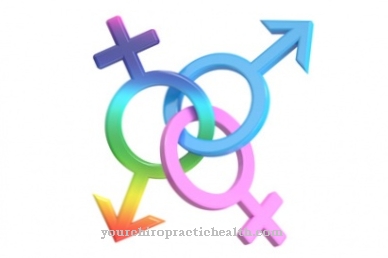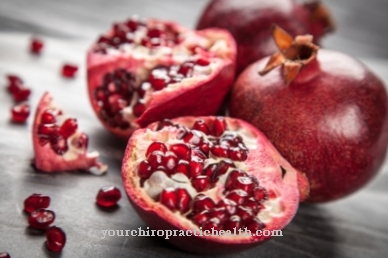The Hydrogen bond is an interaction between molecules that resembles the Van der Waals interactions and occurs in the human body. The bond plays a role especially in connection with peptide bonds and chains of amino acids in proteins. Without the ability to bond with hydrogen bonds, an organism is not viable because it lacks vital amino acids.
What is the hydrogen bond?

Hydrogen bonds are called Hydrogen bonds or H bridges abbreviated. It is a chemical effect that relates to the attractive interaction of covalently bound hydrogen atoms with free electron pairs of an atom grouping atom. The interaction is based on polarity and, described more precisely, consists between the positively polarized hydrogen atoms in an amino or hydroxyl group and lone pairs of electrons in other functional groups.
The interaction occurs only under certain circumstances. One condition is the electronegative property of the free electron pairs. This property must be stronger than the electronegative property of hydrogen in order to create a strong bond. The hydrogen atom can thus be bound polar. Electronegatively free atoms can be nitrogen, oxygen and fluorine, for example.
Hydrogen bonds are secondary valence bonds, the strength of which is usually far below that of covalent bonds or ionic bonds. Molecules in hydrogen bonds have a relatively high melting point and a similarly high boiling point in relation to their molar mass. The bonds are of medical relevance primarily in relation to the peptides and nucleic acids within an organism.
Hydrogen bonds are intermolecular forces. Without their existence, water would not exist in various aggregate states, but would be gaseous.
Function & task
The hydrogen bond has only weak interaction and occurs between two particles or within molecules. In this context, the type of bond plays a role, for example, for the formation of tertiary structures in proteins. In biochemistry, protein structure means the different structural levels of a protein or peptide. The structures of these naturally occurring substances are hierarchically divided into a primary structure, a secondary structure, a tertiary structure and a quaternary structure.
The amino acid sequence is the primary structure. Whenever a protein is mentioned in relation to its spatial arrangement, protein conformations and the phenomenon of conformational change are often referred to. In this context, the change in conformation corresponds to a change in the spatial structure. The arrangement of proteins is based on the peptide bond. This type of bond always connects amino acids in the same way.
In cells, peptide bonds are mediated by ribosomes. Each peptide bond corresponds to a connection of carboxyl groups of one amino acid and amino groups of a second amino acid, which is associated with the elimination of water. This process is also known as hydrolysis.
In every peptide bond, a single bond connects a C = O group with an NH group. The nitrogen atom has exactly one lone pair of electrons. Because of the high electronegativity of oxygen, this free pair is under the electron-withdrawing influence of O2 atoms. In this way, the oxygen partially pulls the lone pair of electrons into the bond between the nitrogen atom and the carbon atom, and the peptide bond acquires a partial double bond character. The double bond character eliminates the free rotation of the NH and C = O groups.
Oxygen atoms and hydrogen atoms of peptide bonds are relevant for the structure formation of all peptides and proteins without exception. In this way, two amino acids can attach to each other. After such an attachment, all peptide bonds of two chains of amino acids are directly opposite one another. The hydrogen atoms in the peptide bond are relatively positively polarized when compared to the oxygen atoms in the directly opposite peptide bonds. In this way, hydrogen bonds form and connect the two amino acid chains with one another.
All amino acids in the human body are organic compounds made up of at least one carboxy group and one amino group. Amino acids are an essential structural component of human life. In addition to the α-amino acids of proteins, more than 400 non-proteinogenic amino acids with biological functions are known that could not arise without hydrogen bonding. Forces such as the hydrogen bond stabilize the tertiary structure of the amino acids.
You can find your medication here
➔ Medicines for muscle weaknessIllnesses & ailments
If there is a disorder in the formation of functional proteinaceous spatial structures, one usually speaks of protein folding disorders. One such condition is Huntington's disease. This genetic disease is inherited as an autosomal dominant trait and is due to a genetic mutation in chromosome 4. The mutation leads to instability of the gene product. The disease is a neurological disease that is primarily associated with involuntary hyperkinesis of the distal extremities and face. Persistent hyperkinesis leads to rigidity in the affected muscles. In addition, patients with the disease suffer from increased energy consumption.
Pathological symptoms in connection with hydrogen bonds or the general protein structure are also present in prion diseases such as mad cow disease. The most popular hypothesis is that BSE induces protein misfolding. These misfolded proteins cannot be broken down by physiological processes and therefore accumulate in the tissue, especially in the central nervous system. The result is degeneration of the nerve cells.
Malformations of the protein structure are also being discussed in the causal connection of Alzheimer's disease. The diseases mentioned do not directly affect the hydrogen bond, but relate to the spatial structure of proteins, to which the hydrogen bond makes a significant contribution.
An organism with an absolute inability to hydrogen bond is not viable. A mutation causing this would result in an abortion in early pregnancy.



























